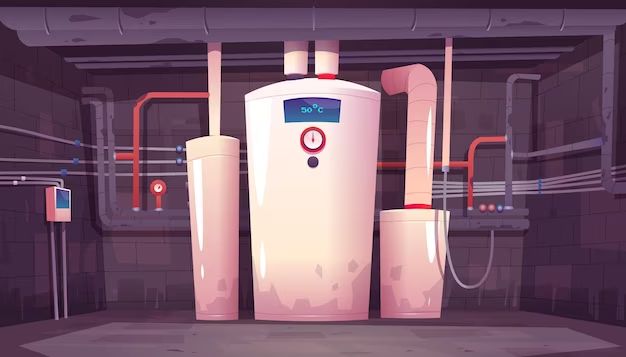Page Contents
Quick Answer
Yes, it is normal for a water heater vent pipe to be hot. The vent pipe allows exhaust gases to escape from the water heater after fuel is burned. This combustion process heats the gases, causing the vent pipe to be hot to the touch. A hot vent pipe indicates that the water heater is functioning properly.
What Is a Water Heater Vent Pipe?
A water heater vent pipe, also known as a flue, is a duct that allows exhaust gases to escape a water heater after fuel is burned. It serves two main purposes:
- Allows exhaust gases to vent safely to the outdoors. These hot gases contain carbon monoxide, a poisonous gas, so proper venting is critical.
- Creates draft to pull air into the combustion chamber. This provides the oxygen needed for fuel burning.
Most residential water heaters are natural draft systems, meaning they rely on the tendency for hot gases to rise to pull exhaust outward. As hot exhaust escapes the vent pipe, it draws fresh air in through a separate intake pipe.
Modern high-efficiency heaters may utilize power vents or induced draft blowers to actively assist the flow of gases. But a vent pipe is still present to direct them outside.
Vent pipes are typically made of PVC, CPVC, or galvanized steel material. They should have a consistent upward slope to allow gases to properly vent. Joints are connected with cement or screws per the manufacturer instructions.
Why Does a Vent Pipe Get Hot?
When gas or fuel oil is burned in a water heater, it produces very high temperatures within the combustion chamber. These temperatures range from 500-600°F for natural gas and 1,100-1,400°F for fuel oil.
As hot exhaust gases exit the combustion chamber, they directly enter the flueway and start rising through the vent pipe. The high temperatures are quickly transferred to the inside metal walls of the vent.
Being exposed to temperatures over 500°F will cause the vent pipe to become extremely hot itself. The exact outer wall temperature depends on various factors, but will be hot enough that touching it would risk a burn injury.
Some key reasons the vent pipe gets hot include:
- The exhaust gases retain heat energy as they flow through the vent, transferring it to the metal walls.
- The vent walls confine the gases, concentrating the heat in a small space.
- Rising motion of the gases maintains velocity, providing constant heat contact.
- The vent pipe has minimal insulation, allowing easy heat transfer.
This heating effect is strongest at the lower end of the vent pipe where it attaches directly to the water heater. But the entire vent system feels hot to the touch during operation.
How Hot Should It Be?
A water heater vent pipe should be hot enough that you cannot keep your hand on it. Exact surface temperatures typically fall into the range of 100-500°F.
Vent pipe walls over 300°F are common for gas heaters. Fuel oil and solid fuel heaters may reach over 500°F in some cases.
The temperature usually decreases slightly as exhaust gases flow through the system and lose some heat along the way. But any portion of the metal vent pipe should feel hot.
Normal Surface Temperature Ranges
| Water Heater Type | Typical Vent Temps |
|---|---|
| Gas | 120-300°F+ |
| Oil | Up to 500°F+ |
| Electric | Warm to hot |
As long as temperatures fall within the expected range for a given fuel type, there is no reason for concern. A hot vent pipe means the water heater is operating normally.
When to Worry
While a hot vent pipe is normal, certain situations do warrant further inspection:
- Soot buildup – Excess soot indicates combustion issues and can block the vent over time.
- Unbearable heat – If the vent is too hot to be near, combustion may be too high.
- Cool spots – Cool sections mean exhaust gases are leaking out.
- Rusting metal – Flaking or bubbling paint from extreme heat.
You should also worry if touching the vent pipe causes a burn injury. While it will be hot, a properly operating system should not burn on contact.
Other issues like strange smells or noises near the water heater require investigation as well.
Improving Vent Pipe Heat
You can take steps to reduce vent pipe temperatures if they are uncomfortably or dangerously hot:
- Seal air intake and exhaust vents – Prevent cool air from entering.
- Insulate the vent pipe – Reduces heat radiated outward.
- Increase vent size – Improves airflow and dilution of gases.
- Check appliance settings – Adjust to optimize combustion.
- Clean intake screen – Removes blockages restricting air.
- Contact professional – For inspection if temperature is extremely high.
Conclusion
A hot water heater vent pipe confirms that the appliance is burning fuel and venting exhaust gases as intended. The high temperatures generated by the combustion process directly heat the vent pipe once gases pass through. Surface temperatures in the range of 100-500°F are typical and indicate standard operation. Any concerns about excess heat or other abnormal vent issues should be addressed right away to maintain safety. With proper maintenance, a hot vent pipe will continue doing its job reliably for years.
